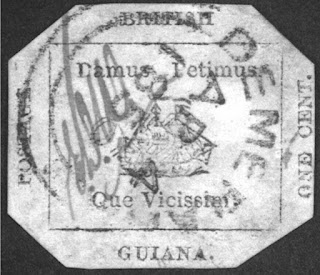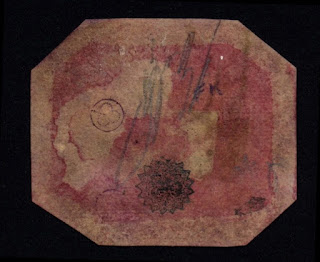There are a number of ''rare'' and ''unique'' philately items, but only one which is accepted as being ''The World's Rarest Stamp''. It is the 1856 British Guiana ''One Cent'' black on magenta. The story of the ''One Cent'' black on magenta has indeed become part of philately history and has been dubbed as the ''Mona Lisa of the stamp world''. The recently paid value in 2021 is US$9.5 million, and now in November 2021, the present value is US$10,364,000.
It is the only survivor of a small batch of temporary printed stamps by the British Colony's postmaster, British Guiana now known as Guiana, in 1856, after a ship from England, thought to be carrying 50,000 stamps, arrived with just 5000.
The story begins in 1856
Short of 90 percent, the local post officials found themselves in a tight spot. If the colony's letters and newspapers were to be delivered, they needed some way to show the transaction of postage paid. So they decided to issue provisional stamps to keep the mail moving until more postage could arrive from overseas. The only place that could create something with enough official cache to do the job in 1850s British Guiana was the local newspaper, the Royal Gazette.
Using movable type, the printer of the Gazette produced a stock of one cent stamps(for newspapers) and four cent stamps (for letters), attempting to imitate the design of government issued postage, adding a stock illustration of the ship and the colony's Latin motto '' 'DAMUS PATIMUS QUE VICISSIM'', meaning, ''we give and expect in return'', and the country name and value. They were trying, very crudely and on a different type of press in the middle of the colony, as closely as they could to replicate the engraved stamps that were coming from Great Britain. They were removed from circulation after about eight to ten weeks after they served their purpose. Most disappeared thereafter.
4 Cent stamp, British Guiana
Background. The first stamps of British Guiana were crudely printed at the offices of the Royal Gazette in Georgetown. To aid identification each value was printed on a different coloured paper and, due to the fear that the stamps would be copied, each had to be initialed by a postal official. The stamps were in use from 01 July 1850. Two print values of 1 cent and 4 cents were designed in a basic design, consisting of a three-masted sailing ship with the Colony's motto 'DAMUS PATIMUS QUE VICISSIM'', meaning, ''we give and expect in return'', and the country name and value. The sailing ship remained a key element of British Guiana stamps until 1934. Waterlow and Sons of London were engaged to print these. On 1 January 1852, the requirement to sign each stamp was dispensed with, however the coloured paper was retained, magenta for 1 cent and deep blue for 4 cents. In 1860, the design was replaced by showing the ship sailing towards the right instead of left.
The first-time supplies ran short at the British Guiana Post Office was in 1865, when the authorities were forced to print a provisional issue. The design was similar to the 1852 production, although the 4 cent was initially printed on red (magenta) paper and later on blue. For fears of counterfeiting, postal officials were instructed to initial all. The 4-cent value was known but somehow the one cent black on magenta was not recognized, its story becoming one of the best known in Philately
The unique stamp, it has to be admitted is not in a finest condition, the magenta paper having darkened. It was signed at the left, with the initials EDW (Edmond D Wight from postal clerk Edmond D Wight) and postmarked ''Demerara ap 4 (a county in British Guiana), 1856'', the four corners cut off, as occurred with many 1856 Provisionals. The stamp measures 29 x 26 mm.
Seen with an infrared, the motto ''Damus Petimus Que Vicissim'' meaning ''We give and we ask in return''
On the back of the stamp, IR pictures show a four-leaf clover beneath the 17-point star
The Story of the Stamp. For the past about 150 years, the stamp has been exchanged from one collector to another, a total of 12 collectors have owned it so far. It was first discovered by a local schoolboy, 12-year-old L Vernon Vaughan, amongst some family papers in 1873. He placed it in his collection, before selling it to a local collector Neil R McKinnon for the sum of six shillings. Vaughan was convinced he would find a better example of the stamp, but no one ever has. A few years later McKinnon sold his collection to a Liverpool stamp dealer Thomas Ridpath, for 120 pounds and Ridpath sold the ''one cent'' to the renowned collector Philipp la Renotiere von Ferrary, an Austrian living in Paris, for an undisclosed sum, believed to be around 40 Pounds. Ferrary died in 1917, intending to leave his collection to the Postal Museum in Berlin.
Thomas Ridpath,
Philipp von Ferrary, (11 January,1850- 20 May,1917)
Hind died in 1933, and the stamp passed on to his wife, who sold it for 45,000 Pounds in 1940 to Fredrick Small, an Australian living in USA. The stamp was sold in 1970 for $280,000, to an investment dealer Irwin Weinberg. Ten years later it was sold to John E du Pont at Robert A Siegel, New York for $935,000. In 1997 du Pont was convicted of murder and spent the rest of his life in prison, dying on 9 December 2010. For these 30 years the stamp was in storage.
In 2014, it again went under the hammer. This time the selling price was more than ten times its previous peak, the buyer paying $9,480,000. The new owner was shoe designer Stuart Weitzman.
Stuart Weitzman
After seven years the stamp returned to the auctioneer's rostrum, at Sotheby's in New York on 8 June 2021, when it achieved a total price of $8,307,000. The buyer was Stanley Gibbons Ltd.
The stamp for 8.3 million (US) Dollars (6.3 million British Pounds) is on display till 18 December at Stanley Gibbons store in London now. As the chief executive of Stanley Gibbons, said, ''The British Guiana 1 cent magenta really is the Holy Grail of philately''.
The stamp on display at Stanley Gibbons, London
The stamp is now on display to the public















No comments:
Post a Comment
Any inputs or feedback is welcome!